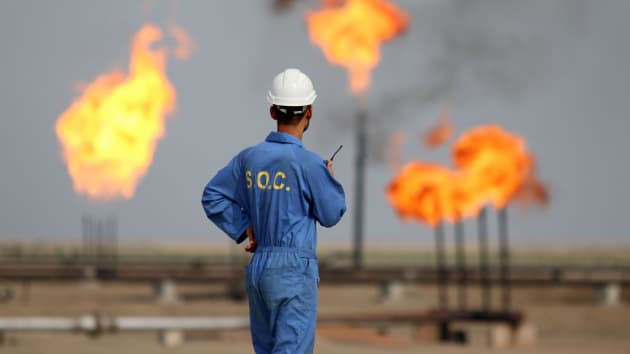Kategori : ENERGY AGENDA NEWS, OIL & FUEL SECTOR NEWS - Tarih : 19 April 2020
OPEC and its oil producing allies on Sunday finalized a historic agreement to cut production by 9.7 million barrels per day, following days of discussions among the world’s largest energy producers. It’s the single largest output cut in history.
West Texas Intermediate crude, the U.S. benchmark, fell 1.54% on Monday to settle at $22.41 per barrel. Brent crude traded 34 cents higher at $31.82.
Sunday’s emergency meeting — the second in four days — came as oil-producing nations scrambled to  reach an agreement in an effort to prop up falling prices as the coronavirus outbreak hammers demand. The agreement ends a Saudi Arabian-Russian price war that broke out at the beginning of March and had pressured oil prices as each sought to gain market share.
reach an agreement in an effort to prop up falling prices as the coronavirus outbreak hammers demand. The agreement ends a Saudi Arabian-Russian price war that broke out at the beginning of March and had pressured oil prices as each sought to gain market share.
On Thursday, OPEC+ proposed cutting production by 10 million barrels per day — amounting to some 10% of global oil supply — but Mexico opposed the amount it was being asked to cut, holding up the final deal.
Talks continued on Friday when energy ministers from the Group of 20 major economies met, and while all agreed that stabilization in the market is needed, the group stopped short of discussing specific production numbers.
Under OPEC+’s new agreement, Mexico will cut 100,000 bpd, a quarter of what it had been asked to cut on Thursday.
The 9.7 million bpd cut will begin on May 1 and will extend through the end of June. The cuts will then taper to 7.7 million bpd from July through the end of 2020, and 5.8 million bpd from January 2021 through April 2022. The 23-nation group will meet again on June 10 to determine if further action is needed.
“This is at least a temporary relief for the energy industry and for the global economy,” Rystad Energy’s head of analysis Per Magnus Nysveen told CNBC in an email. “Even though the production cuts are smaller than what the market needed and only postpone the stock building constraints problem, the worst is for now avoided.”
President Donald Trump, who has been heavily involved in brokering a Saudi Arabian-Russian price war, said in a tweet that it’s a “great deal for all” that “will save hundreds of thousands of energy jobs in the United States.”
On Friday, when the deal was in jeopardy, Trump said the U.S. would cut production in an effort to get Mexico “over the barrel.”
At a White House press briefing, Trump said he spoke to Mexico’s President Andres Manuel Lopez Obrador and had agreed to “pick up some of the slack” by cutting production on behalf of Mexico. He did not elaborate on how the cuts would be enacted, and said Mexico would reimburse the U.S. at a later date.
OPEC+ is hoping that nations outside of the group, including the U.S., Canada and Norway, will also cut production to shore up prices. While Trump previously stopped short of saying the U.S. would scale back production, he has noted that market forces would naturally curb output.
U.S. Energy Secretary Dan Brouillette reiterated this point on Friday, saying that about 2 million bpd and perhaps 3 million bpd of U.S. production would have been taken offline by the end of the year.
“Today’s crisis transcends the interests of any one nation and requires a swift and decisive response from us all. Failure to act has far reaching consequences to each of our economies,” he said Friday at the G-20 meeting. “This is a time for all nations to seriously examine what each can do to correct the supply/demand imbalance,” he added.
“Unprecedented measures for unprecedented times,” Ed Morse, Citi’s global head of commodities, wrote in a note to clients Sunday. “Unprecedented in historical discussions of production cuts, the US played a critical role in brokering between Saudi Arabia and Russia to induce them to negotiate the new OPEC+ accord.”
Despite the record size of the cut, some fear it’s still not large enough to combat the drop in demand. On Thursday, West Texas Intermediate crude dropped more than 9%. The market was closed on Friday.
Both Brent and WTI futures are in bear market territory, down 53% and 63% respectively since climbing to a January peak.
Chris Midgley, S&P Global Platts’ global head of analytics, said that the cut isn’t enough “to plug the 15- to 20-million b/d near-term imbalance in the marketplace and avoid tank tops in May.” The cut “won’t be enough to bring sustainable, restorative support to oil prices, not unless OPEC goes further,” he added.
But Ann-Louise Hittle, vice president of macro oils at Wood Mackenzie, noted that the deal “will make a difference to the market,” even if “poorly implemented.”
“We expect the second half of 2020 to show an implied stock draw, in contrast to the record-breaking oversupply of the first half of 2020,” she said.





